

Hindu Goddesses : Saraswati - Goddess of knowledge and arts. Tārā - A Beautiful Goddess for a Not-So-Beautiful World - Kashgar Tribal Artifacts - Life for the Modern Nomad. By Linda Heaphy Tārā is a female bodhisattva and an important goddess deity in both Buddhism and Hinduism.
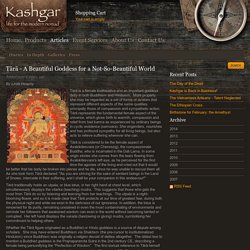
More properly, she may be regarded as a set of forms or avatars that represent different aspects of the same qualities, principally those of compassion and sympathetic action. Muses, the Goddesses of Art and Science in Greek Mythology. MUSES : Greek Goddesses of Music, Poetry & the Arts. THE MOUSAI (Muses) were the goddesses of music, song and dance, and the source of inspiration to poets.
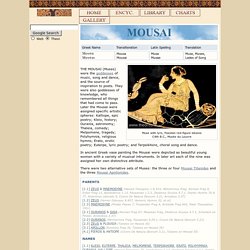
They were also goddesses of knowledge, who remembered all things that had come to pass. Later the Mousai were assigned specific artistic spheres: Kalliope, epic poetry; Kleio, history; Ourania, astronomy; Thaleia, comedy; Melpomene, tragedy; Polyhymnia, religious hymns; Erato, erotic poetry; Euterpe, lyric poetry; and Terpsikhore, choral song and dance. In ancient Greek vase painting the Mousai were depicted as beautiful young women with a variety of musical intruments.
In later art each of the nine was assigned her own distinctive attribute. There were two alternative sets of Muses: the three or four Mousai Titanides and the three Mousai Apollonides. Homer, Iliad 2. 597 ff (trans. Homer, Odyssey 8. 457 ff (trans. Hesiod, Theogony 1 ff (trans. Homeric Hymn 32 to Selene (trans. Eumelus, Fragment 35 (from Tzetzes, On Hesiod's Works & Days 23) (trans.
Macha, Irish Goddess of War. Macha. Macha (Irish pronunciation: [ˈmaxə]) is a goddess of ancient Ireland, associated with war, horses, sovereignty, and the sites of Armagh and Eamhain Mhacha in County Armagh, which are named after her.

A number of figures called Macha appear in Irish mythology, legend and historical tradition, all believed to derive from the same deity. The name is presumably derived from Proto-Celtic *makajā denoting "a plain" (genitive *makajās "of the plain").[1] Myths, Fairies, and me: 2014-03-23. Aine: Goddess of Midsummer - Goddess Alive! By Lana Jarvis ''Aine' artwork by Wendy Andrew.

Hecate. Ancient Greek goddess of magic and crossroads Hecate was one of the main deities worshiped in Athenian households as a protective goddess and one who bestowed prosperity and daily blessings on the family.[5] In the post-Christian writings of the Chaldean Oracles (2nd–3rd century CE) she was regarded with (some) rulership over earth, sea, and sky, as well as a more universal role as Savior (Soteira), Mother of Angels and the Cosmic World Soul.[6][7] Regarding the nature of her cult, it has been remarked, "she is more at home on the fringes than in the center of Greek polytheism.

Intrinsically ambivalent and polymorphous, she straddles conventional boundaries and eludes definition. "[8] Name and origin[edit] Dark Moon. I am the dark Goddess, I am Hecate I am the Darkness behind and Beneath the Shadows I am the absence of air that waits at the bottom of every breath I am the Ending before Life begins again.
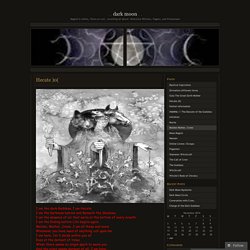
Maiden, Mother, Crone…I am all these and more. Whenever you have need of anything call upon me. I am here…for I abide within you all Even at the darkest of times When there seems no single spark to warm you And the night seems darkest of all, I am here… Watching and waiting to grow within you In strength and in love. Come to me and see that which cannot be seen, Face the terror that is yours alone. Dark Moon. Dark Moon. Journeying to the Goddess. “Lakshmi’s themes are devotion, luck, wealth, relationships, prosperity, love, the harvest and autumn.
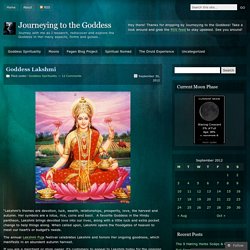
Her symbols are a lotus, rice, coins and basil. A favorite Goddess in the Hindu pantheon, Lakshmi brings devoted love into our lives, along with a little luck and extra pocket change to help things along. When called upon, Lakshmi opens the floodgates of heaven to meet our heart’s or budget’s needs. The annual Lakshmi Puja festival celebrates Lakshmi and honors Her ongoing goodness, which manifests in an abundant autumn harvest. If you are a merchant or store owner, it’s customary to appeal to Lakshmi today for the ongoing success of your business. For those wishing luck in love, gather a handful of rice cooked in basil water (the cooking process adds energy and emotional warmth). ‘Lakshmi, let true love find its way to my home; Let me carry luck with me wherever I roam.’
Keep a pinch of this in an airtight container and carry it with you into social situations. “Laksmi” by Hrana Janto. Sekhmet. In Egyptian mythology, Sekhmet /ˈsɛkˌmɛt/[1] or Sachmis (/ˈsækmɨs/; also spelled Sakhmet, Sekhet, or Sakhet, among other spellings) was originally the warrior goddess as well as goddess of healing for Upper Egypt, when the kingdom of Egypt was divided.
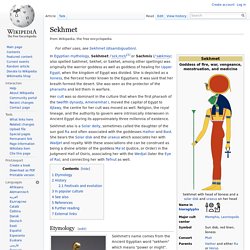
She is depicted as a lioness, the fiercest hunter known to the Egyptians. It was said that her breath formed the desert. She was seen as the protector of the pharaohs and led them in warfare. Sekhmet also is a Solar deity, sometimes called the daughter of the sun god Ra and often associated with the goddesses Hathor and Bast. She bears the Solar disk and the uraeus which associates her with Wadjet and royalty. Etymology[edit] Sekhmet - The Goddess of War. Ancient Luxor. The Goddess Sekhmet - Luxor at its best. Sekhmet and the chaos principle: The most well-known myth surrounding the warlike and destructive aspects of Sekhmet is that found in many of the royal tombs at Thebes.
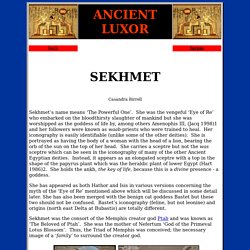
It is said that Re was afraid that humans were about to revolt against his rule and thus weaken, or even destroy, his powers. He was urged by the gods to send his ‘Eye’ in the form of Sekhmet (also depicted in some versions as Hathor or Isis) to teach mankind a lesson. Re ordered Sekhmet to mete his revenge on those who were seeking to destroy his absolute rule. But things went horribly wrong. Ancient Luxor. The Goddess Sekhmet - Luxor at its best. Egyptian Goddess Sekhmet. Egyptian Goddess Sekhmet. Embracing Cailleach's Wild Winds of Winter. Celtic Myth and Moonlight. The modern portrayal of Santa Claus frequently depicts him listening to the Christmas wishes of young children.
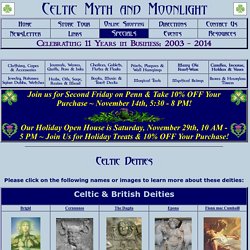
Santa Claus, or Santa, is a figure in the culture of North America, The United Kingdom, Ireland,Australia, New Zealand and more who reflects an amalgamation of the Dutch Sinterklaas, the English Father Christmas, and Christmas gift-bringers in other traditions. Santa Claus is said to bring gifts to the homes of good children during the late evening and overnight hours of Christmas Eve, December 24. Santa Claus in this contemporary understanding echoes aspects of hagiographical tales concerning the historical figure of gift-giver Saint Nicholas, the man from whom the name of Santa Claus derives and in whose honor Santa Claus may be referred to as Saint Nicholas or Saint Nick. According to a tradition which can be traced to the 1820s, Santa Claus lives at the North Pole, with a large number of magical elves, and nine (originally eight) flying reindeer. Predecessor Figures. Celtic Prayers & Druid Prayers Celtic Rituals. Celtic Prayer Book May the blessing of light be on you - light without and light within.
Top May the blessed sunlight shine on you like a great peat fire, so that stranger and friend may come and warm himself at it. Airmed. Airmid. Nuada Airgetlám. In Irish mythology, Nuada or Nuadu (modern spelling: Nuadha), known by the epithet Airgetlám (modern spelling: Airgeadlámh, meaning "silver hand/arm"), was the first king of the Tuatha Dé Danann. He is cognate with the Gaulish and British god Nodens. His Welsh equivalent is Nudd or Lludd Llaw Eraint. Description[edit] Nuada was king of the Tuatha Dé Danann for seven years before they came to Ireland.
Goddess Gallery. The Goddess of the Five Elements Pewter Pendant on Cord Necklace, The Wiccan Collection by US Jewellery - Shop Online for Jewellery in Australia. Sheela na gig. Ireland has the greatest number of known sheela na gig carvings; McMahon and Roberts cite 101 examples in Ireland and 45 examples in Britain.[1] Such carvings are said to ward off death and evil.[2][3] Other grotesques, such as gargoyles and hunky punks, were frequently part of church decorations all over Europe.
It is commonly said that their purpose was to keep evil spirits away (see apotropaic magic). They often are positioned over doors or windows, presumably to protect these openings. Origin[edit] Macha. Name: Macha.